Spin Echo SANS for magnetic samples
S.V.Grigoriev, Yu. O. Chetverikov, V.N. Zabenkin (Petersburg Nuclear Physics Institute, St.Petersburg, Russia)
M.Th. Rekveldt, W.H. Kraan, N.van Dijk (Delft University of Technology, The Netherlands)
Angle encoding scheme with Larmor precession

The polarizer, the p/2 flipper , the precession device, a precession device, the second p/2 flipper, the second polarizer and the detector.
The concept of Spin Echo SANS
M.Th. Rekveldt, J.Nucl.Instr.Meth. B, 114 (1996) 366 .

The spin echo setup: polarizer P, two precession devises C1, C2 ; spin flipper SF, Analyzer A, Detector Det
Result is Fourier transform scattered intensity: ~ Density correlation function!
Alternative picture of SESANS
concept of coherent volumes

R. Gähler, J. Felber, F. Mezei, and R. Golub, Phys. Rev. A 58, 280 (1998).
Magnetic extension of SESANS
Magnetic sample changes polarization at the moment of scattering !
1) Paramagnetic scattering: PS = - e (e P0) for NSE.
2) Ferromagnetic scattering: PS = 2(m P0)m – P0 for SESANS.


1) M = 0 2) M = 0 3) M = MZ
P is flipped and s = s0 (1 - (e m )2) = s0
Simple math of magnetic SESANS

![]()
![]()
![]() with
with
![]()
The expression is valid in the single scattering regime
For multiple scattering
![]()
Experimental SESANS setup, Delft, The Netherlands

Schematic drawing of the SESANS setup at IRI TUDelft: MC monochromator crystal, P polarizer, R1, R2, R3 and R4 polarization rotators, M1, M2, M3 and M4 electromagnets, S sample position, A analyzer, D detector. The system consisting of M1 and M2 make up the first arm of a spin echo setup; M3 and M4 its second arm.
Experiment on a sample of Ni layer on Cu plate

Thickness dependence

SESANS curves for the samples with different thickness of Ni layer: L=10,15,21 mkm
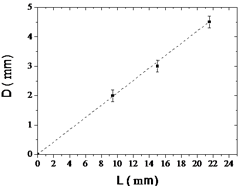
The width of the domains D versus thickness of the Ni layer or length of the domains L.
Experiment: SESANS curve

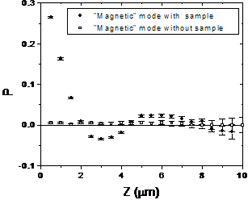
The polarization versus parameter Z ~ B for the "nuclear" (with flipper) and "magnetic" mode (without flipper).
Multiple scattering
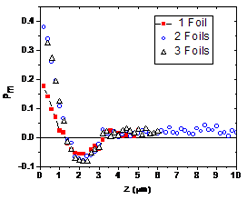
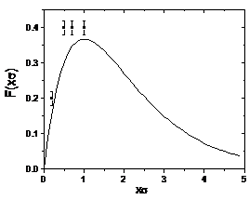
Amplitude of SESANS curve versus number of foils ( scattering events)
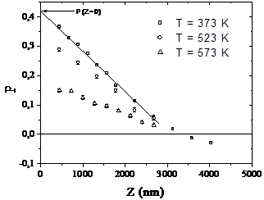
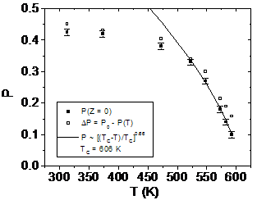
SESANS curves for T=373,523,573 K
Amplitude of SESANS curve versus temperature T
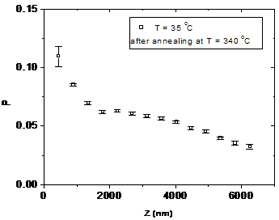
SESANS curve after annealing. The domain structure changes: part of the domains are magnetized perpendicular to the plate with size of order of 2 mkm; another part of the domains are magnetized in the plane with size of order of 10 mkm.
Future applications
This technique (Magnetic SESANS) is promising for applications in the directions:
(i) investigation of the ferromagnetic materials for industry (magnetic memory devises, magnetic steel, etc.)
(ii) investigation of the ferromagnetic temperature transformations in magnetic memory alloys; gigantic magneto-resistance materials; ferromagnetic invars; etc.
(iii) magnetic quantum phase transitions under applied pressure.
The development of the this technique will be done in the following directions:
(i) The sample environment to work with the magnetic field. This part requires both theoretical and experimental efforts for its realization. First, the magnetic field applied changes not the state of the magnetic system only but also the magnetic situation around the sample. Secondly, the interpretation of the experimental points obtained becomes different in presence of the magnetic field as compared to the situation without field.
(ii) The sample environment to vary the temperature of the sample from 2 to 300 K with the thermostat and from 300 to 600 K with the oven. This environment is important to study the temperature phase transitions.
(iii) The sample environment to work with the pressure cell at room temperature and at low temperatures. This is important for studying the quantum phase transitions, which is at the very forefront of the Condensed matter research because of a close relation to various fundamental problems such as the breakdown the Fermi-liquid theory, heavy-fermion physics and unconventional superconductivity.
[1] Grigoriev S.V., Kraan W.H., Rekveldt M.Th., Kruglov T. and Bouwman W.G. (2006). J.Appl.Cryst. 39, 252-258 – Spin echo SANS for magnetic samples.
[2] Grigoriev S.V., Chetverikov Yu.O., Zabenkin V.N., Kraan W.H., Rekveldt M.Th., van Dijk N. (2006). J.Appl.Cryst. Proceedings of SAS2006 – SESANS study of domain structure of Ni layer on Cu substrate.
ACKNOWLEDGMENTS
One of the authors (S.G.) thanks NWO for a grant, which enabled him to perform this work in the Faculty of Applied Science of TU Delft. The work was partly supported by INTAS foundation (Grant No. INTAS-03-51-6426), RFFR (project 05-02-16558). The research
project has been partially supported by the European Commission under the 6th Framework Programme through the Key Action: Strengthening the European Research Area, Research Infrastructures. Contract n°: RII3-CT-2003-505925.